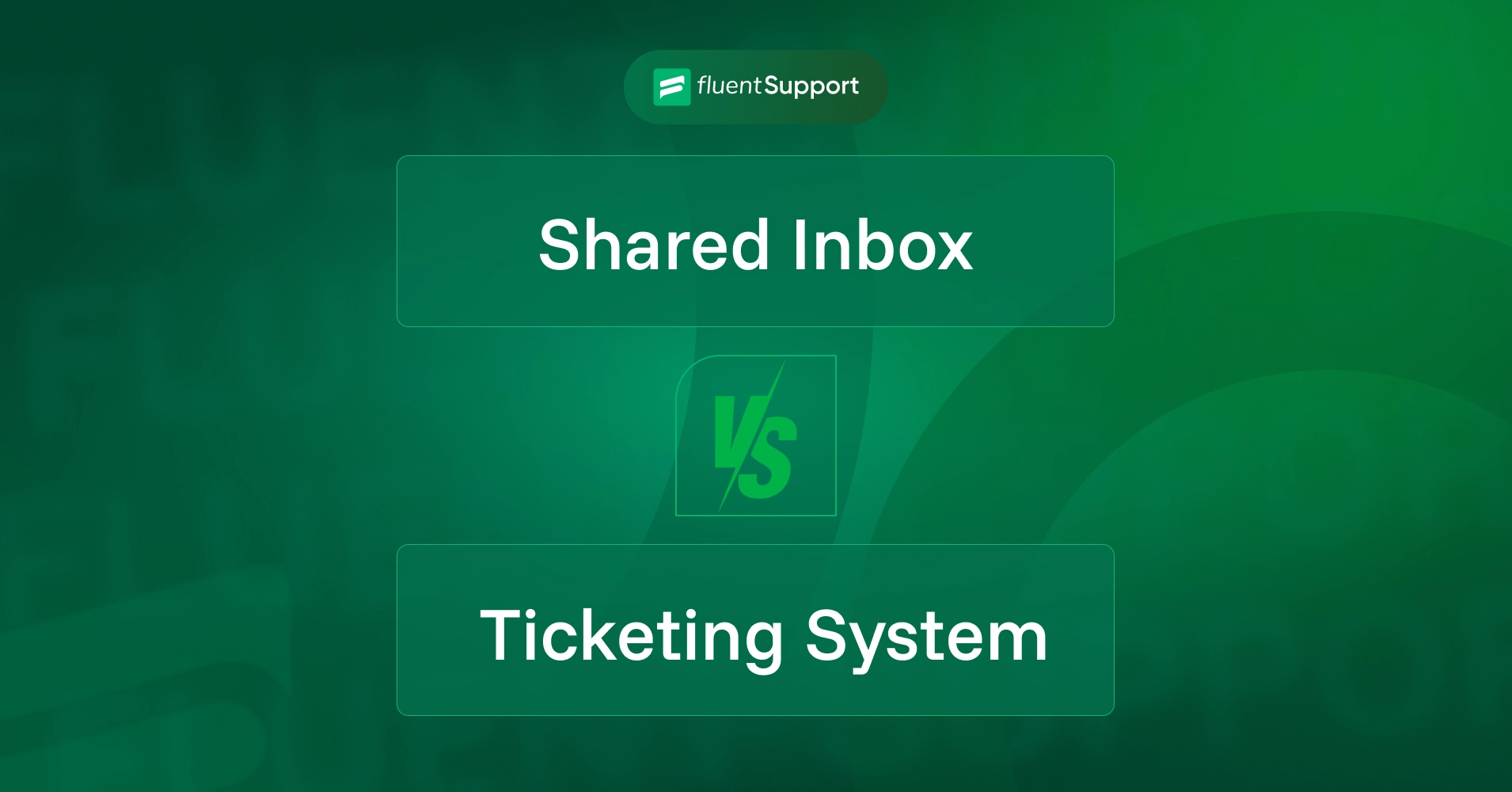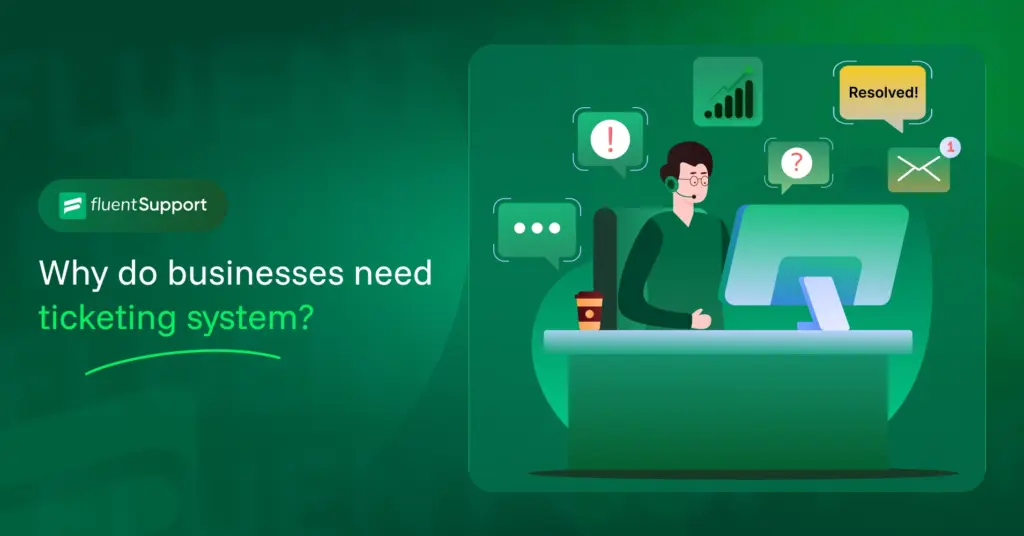
Difference Between a Shared Inbox and a Ticketing System
By Md. Sajid Sadman
November 28, 2025
Last Modified: November 28, 2025
You know the feeling: staring at a shared support inbox that looks more like a communication black hole. Everyone sees the email, but no one knows who is supposed to reply, and suddenly, two agents send conflicting answers. That is shared inbox anxiety in action.
For small teams, the shared inbox is fine. But when volume increases, that guessing game quickly turns into professional chaos. Priorities vanish, history is lost, and the customer experience suffers.
This is why the difference between a simple shared inbox and a structured ticketing system is so critical. One is a storage folder. The other is a professional tracking engine.
In this guide, we are cutting through the confusion. You will get a clear, punchy breakdown of the differences so you know exactly when it is time to upgrade (or you may keep working on the shared inbox).
TL;DR
What is a shared inbox?
A shared inbox is a standard email account, like support@company.com, that multiple team members access simultaneously. It is typically managed through basic folders and the standard reply-all function.
Teams often use it for low-volume communication, internal coordination, or very small initial support queries. It is simple to set up and requires no specialized tools.
The critical flaw of the shared inbox is its lack of structure. There is no automatic tracking, no assigned ownership, and no system to prevent agent conflict. This means accountability is based solely on trust and memory.
What is a ticketing system?
A ticketing system is a specialized platform designed to solve the core problems of the shared inbox. It converts every message into a clean, trackable record called a ticket.
Its function is to enforce structure across the entire support workflow. It routes, prioritizes, and assigns clear ownership to every request. This assignment can be handled by agents manually or through automation rules.
The system eliminates guesswork. Every history is clear, every action is logged, and accountability is total. This ensures that customers receive consistent support across every channel. Agents no longer require customers to repeat their issues.
You have seen why a structured ticketing system is non-negotiable for accountability and growth. Now you need a system that delivers on that promise.
Fluent Support is built to enforce this structure. It gives you the clear ownership, fast routing, and comprehensive history required to move beyond the limits of a shared inbox.
Shared inbox vs. ticketing system: the core differences
The fundamental difference between these two systems goes far beyond basic organization. It comes down to professionalism versus guesswork. One is designed purely for communication, and the other is engineered for structured resolution.
To choose the right solution, you must understand where the shared inbox inherently fails and where the ticketing system enforces necessary structure.
1. Workflow structure
Shared inbox: Workflow is nonexistent. Agents rely on memory or external messages to track who is working on what. This quickly leads to inconsistency.

Ticketing system: Workflow is enforced. Every ticket moves through defined stages. This makes the support process predictable for agents and customers alike.
2. Assignment & ownership
Shared inbox: Ownership is always fuzzy. Agents must manually claim an email, and the risk of two people replying to one thread is constant.

Ticketing system: Ownership is total. A ticket is instantly assigned to one agent or team. This removes all doubt about accountability.
3. Collaboration
Shared inbox: Collaboration is messy. Agents must forward emails or use external tools like Slack. This fragments the customer conversation history.

Ticketing system: Collaboration is seamless. Internal notes, mentions, and private discussions happen directly on the ticket. This keeps all context in one place.
4. Tracking & accountability
Shared inbox: Tracking is manual. There is no way for a manager to know if an email was accidentally missed or intentionally forgotten.

Ticketing system: Tracking is automatic. The system logs every status change and action. This ensures total accountability from the moment of submission.
5. Scalability
Shared inbox: It breaks at volume. If you add more agents to the same inbox, confusion and collision risk increase.

Ticketing system: It thrives on volume. It uses routing and automation to manage increased ticket load efficiently. This ensures service quality remains high.
6. Customer experience
Shared inbox: The customer often repeats their issue or gets delayed replies because of internal confusion and the need to manually look up answers.

Ticketing system: The customer gets fast, consistent replies because the agent has instant access to the full history and context.
7. Reporting & insights
Shared inbox: Reporting is nonexistent. Managers rely on guesswork or manual spreadsheets to measure response time or resolution rate.

Ticketing system: Reporting is data-driven. It automatically tracks key metrics. This gives managers clear signals on performance and pain points instantly.
8. Automation capabilities
Shared inbox: Automation is impossible. There are no rules for smart assignment, auto-tagging, or escalation management.

Ticketing system: Automation is integrated. It uses conditional logic to handle repetitive tasks. This lets agents focus on complex, meaningful conversations.
Just a heads up: You have seen that the shared inbox offers zero logic for smart assignment or auto-tagging. This is where the ticket system truly pays off.
If you want to see how robust, real-world automation is structured, check out Fluent Support’s workflow automation system. It shows the powerful logic required to scale support effortlessly.
Comparison table
After reviewing the core differences, the contrast becomes clear. A shared inbox is purely passive communication, while a ticketing system is an active engine for structured problem-solving.
This table summarizes the 8 core operational differences:
Aspect | Shared Inbox | Ticketing System |
Workflow | Non-existent; relies on agent memory. | Enforced stages; predictable process. |
Ownership | Undefined! Requires agents to claim issues. | Total! Instant assignment to one owner. |
Collision | High risk of duplicate replies and errors. | Collision detection prevents agent overlap. |
Context/History | Fragmented. Requires external search or customer request. | Centralized. Full conversation history on the ticket. |
Scalability | Breaks at high volume; struggles with new hires. | Thrives on volume; uses automation for load management. |
Accountability | Manual. No audit log for missed items. | Automatic. Logs every status change and action. |
Reporting | Non-existent! Requires manual spreadsheet updates. | Automatic! Tracks all key performance metrics instantly. |
Automation | Impossible. No logic for route or auto-tag features. | Integrated. Uses conditional logic for assignment and replies. |
When should your team switch from a shared inbox to a ticketing system?
A shared inbox works… until it really doesn’t. Most teams don’t wake up one day and decide to “upgrade their support tools.” They switch because the cracks become impossible to ignore.
Here are the clearest signs your shared inbox has reached its limit:
1. You keep missing customer messages
If customers say, “Hey, just following up on my previous email…” you already know the answer. Shared inboxes hide emails inside threads, promotions filters, or someone else’s unread pile. When even one message slips past you, the customer feels ignored, and trust takes a hit.
2. Multiple agents reply to the same customer
Two agents jump onto the same email. Two different answers go out. And the customer wonders if your team actually talks to each other. This is one of the earliest (and most embarrassing) signs that your shared inbox can’t handle the load.
3. You have no idea who’s working on what
Someone says, “I’ll take this.” Then they go to lunch. Or leave early. Or forget. Without assignments, your team relies on memory instead of a system. That works with five emails a day, not fifty.
4. You spend more time organizing than replying
If your team burns minutes or hours, creating folders, tagging emails, starring messages, forwarding threads, or manually tracking follow-ups… You’re doing work the system should be doing for you.
5. High-priority issues don’t get prioritized
A shared inbox treats every message the same. A refund request and a critical bug alert sit side by side. Unless someone manually flags them, urgent issues wait far longer than they should.
6. Your support volume is growing faster than your workflow
More customers equals more messages. More messages equal more chaos. More chaos equals slower replies and stressed agents. A growing business cannot scale on shared inbox guesswork.
7. You need reporting, but your inbox gives you… nothing
With a shared inbox, you have no way to answer basic questions: How fast is your team responding? Who handles the most tickets? What issues happen most often? Where are your bottlenecks? “No data” means “no improvement.”
8. New agents take forever to get up to speed
When every piece of customer history is buried in email threads, onboarding becomes detective work. A ticketing system gives new agents instant context. A shared inbox gives them a headache.
9. You’re ready to look professional
If your team wants: consistent replies, clear processes, faster resolution times, predictable outcomes, and fewer mistakes… a shared inbox can’t deliver those at scale. A ticketing system doesn’t just organize. It elevates.
The rule is simple: If your shared inbox causes stress, confusion, or missed replies, you’ve already outgrown it. A ticketing system isn’t just an upgrade. It’s the moment your support becomes organized, reliable, and ready to scale.
Wrapping up
You now have the full picture. The difference between a shared inbox and a ticketing system is not about price; it is about infrastructure. One is designed for communication storage. The other is engineered for resolution and growth.
The shared inbox works for a moment, but it actively promotes chaos, collision, and guessing when volume increases. A ticketing system, conversely, enforces accountability, tracks every action, and ensures your service quality remains predictable.
If your support team is experiencing any of the signs we discussed, the decision is clear. Moving to a structured system is the moment your business chooses reliability over risk.
Start off with a powerful ticketing system that delivers smooth collaboration right out of the box.












Leave a Reply